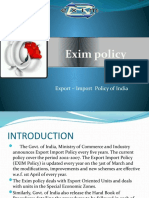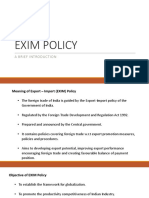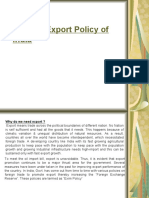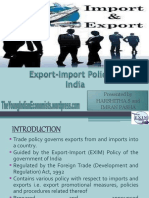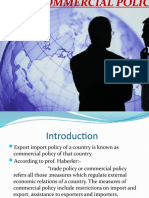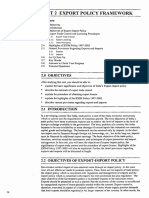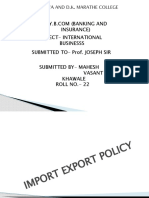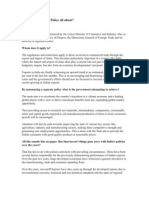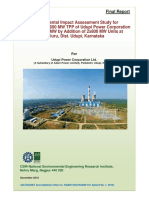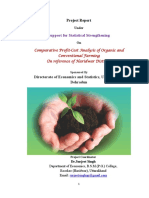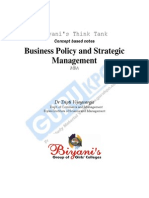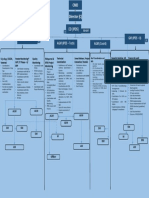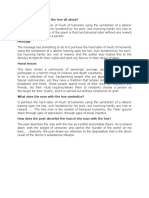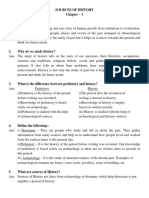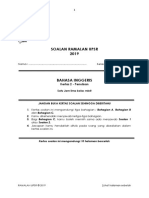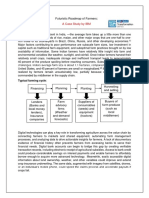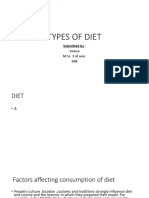Export-Import Policy
Lalit Mohan Pant
Pal college of Technology & Management
Haldwani
Contents
Introduction
Why do we need export, brief history
Exim policy ,objectives
Export Promotion Measures
Import Control in India
Pre 90s Exim Policy of India
Post 90s Exim Policy of India
Why do we need export
Export means trade across the political boundaries of different nation. No
Nation is self sufficient and had all the goods that it needs. This happens
because of climatic variation & unequal distribution of natural resources.
As a result, countries all over the world have become interdependent, which
necessitated foreign trade. A developing country like India with its fast
growing agricultural production to keep pace with the population to keep
pace with the population growth and growing Industrial infrastructure
needs high-import and this can be sustained only with fast export growth.
To meet the oil import bill, export is unavoidable. Thus, it is evident that
export promotion continues to be a major thrust area for the government.
Several measures have been under taken in the past for improving export
performance of the country. In India, Govt. has come out from time to time
with various policies on foreign trade to promote export thereby increasing
the Foreign Exchange Reserve. These policies are termed as Exim
Policy
Brief history
Import export act was introduced by gov during second
world war and it lasted for around 45 yrs and in June
1992 this act was superceded by the Foreign Trade
(Development & Regulation Act), 1992. . The basic
objective of this new act was to give effect to the new
liberalized export and import policy of the Govt. till 1985
annual policies were made but from 1985-92, three yr
policy was made and then 5 yr policy was made
coinciding with 5 yr plans 1992-97, 1997-02, 2002-07.
What is Exim Policy?
It contains policies in the sphere of Foreign trade
i.e. with respect to import & export from the
country and more especially export promotion
measures, policies and procedure related there to.
Export means selling abroad and import as
bringing into India, any goods and services
Objective of Exim Policy
Accelerating the countrys transition to a globally oriented
vibrant economy with a view to derive maximum benefits
from expanding global market opportunities;
Stimulating sustained economic growth
Enhancing the technological strength and efficiency
Encouraging the attainment of internationally accepted
standards of quality
Providing consumers with good quality products and
services at reasonable prices.
General provisions regarding export import
Exports and Imports free unless regulated
Compliance with Laws
Interpretation of Policy
Procedure:
Exemption from Policy/ Procedure
Principles of Restriction
Restricted Goods
Terms and Conditions of a Licence
Importer-Exporter Code Number
Exemption from Bank Guarantee
Clearance of Goods from Customs
EXPORT PROMOTION MEASURES
Policy measures
Institutional set up.
Import Facilitation for Export Production.
Cash subsidies.
Fiscal Incentives.
Foreign Exchange Facilities.
Export incentives
Export production units
Import Facilitation for Export Production
Export Promotion Capital Goods Scheme
Special Import Licences
Duty Free Licences under Duty Exemption Scheme
Duty free licences are issued as :
(1) Advance licence
(2) Advance Intermediate licence.
(3) Special Imprest licence.
(4) Licence for jobbing, repairing etc. for re-export.
(5) Licence under export production programme.
(6) Advance Release Order.
(7) Back to Back Inland Letter of Credit.
Export Incentives
Duty Exemption
Duty Drawback Scheme
DFRC (Duty free replenishment certificate)
DEPB( Duty entitlement pass book)
Deemed Exports
Export Production Units
Export Oriented Unit (EOU)
Special Economic Zones (SEZ)
Software Technology Parks (STP)
Electronic Hardware Technology Parks (EHTP)
Cash subsidies
Marketing development assistance
Air freight subsidy
Spices export promotion scheme
Jute externel marketing assistance
Financial assistance scheme agriculture
&meat exports
Financial assistance to marine products
exports
Fiscal incentives
Exemption from payment of central excise duty &
simplified procedure for clearance.
Exemption from sales tax
Exemptions & deductions under income tax
act,1961.
Duty draw back Scheme (DDS)
Cash Compensatory Support ( CCS )
International Price Reimbursement Scheme
(IPRS)
Import control regime
1956-57, restrictions on imports started as lot of imports were there as such gov
even had to import food grains for self fulfillment
Imports were classified into
Banned items ,Canalized items ,Restricted items, OGL
In 1966 ruppee was devalued by 36.5% By devaluation gov expressed the hope that
the devaluation would lead to expansion in export earnings as Indian goods will
become cheaper in international market on the other hands import would decline as
price of imported goods would increase.
Because of a rigid itemization of permissible imports, an element of inflexibility in
the pattern of utilization of imports was introduced. The transferability of licenses
among same and different industries was not permissible. This gave rise to an
expanding black market in import licenses. Therefore, the import allocation system
was so designed as to eliminate the possibility of all competition, either domestic or
foreign. The Govt of India has liberalized the import regime from time to time. At
present, practically all controls on import have been lifted. Under the new EXIM
policy 2002-07.
Comparison of Pre 90s & Post 90s Exim Policy
Year
Import Export
(Cr.)
(Cr.)
Trade
Bal.(Cr.)
1948-51
650
647
-3
Excess of Import due toPent-up demand of war.
Shortage of food & raw material due to
partition.
Import of capital goods due to starting
of hydro-electric & other projects.
1951-56
730
622
-108
Trade deficit was largely due to
programmes of industrialization which
gathered momentum and pushed up the
imports of capital goods.
No improvement in exports.
Year
Import Export
(Cr.)
(Cr.)
Trade
Bal.(Cr.)
1956-61
1080
613
-467
Excess of import due to setting of steel
plants,heavy expansion & renovation on
railways & modernization of many
industries.
Export lower than occur in second plan
which shows that export promotion drive
did not materialize.
1961-66
1224
747
-477
Excess of import due toRapid industrialization needs capital
goods as raw material.
Defence needs had increased due to
aggression by China & Pakistan.
Need of foodgrains due to failure of
crops in 1965-66.
Year
Import Export
(Cr.)
(Cr.)
Trade
Bal.(Cr.)
1966-69
(Annualplans)
5775
3708
-2067
Devaluation was resorted to essentiallyTo reduce volume of import.
To boost export.
Create favourable balance of trade and
balance of payment.
1969-74
1972
1810
-162
As a consequence of import restriction
policies with vigorous export promotion
measures ,during 1972-73 the country
had favourable balance of trade for first
time since independence.
But several international factors pushed
up
the
price
of
petroleum
product,steel,fertilizers etc.results low
magnitude of trade balance.
Year
(Cr.)
(Cr.)
Trade
Bal.(Cr.)
5540
4730
-810
Significant increase in export during
every year of this period.Export of
coffee,tea,cotton fabrics etc.recorded
substantial increase in this period.
But,Janta Government followed policy of
haphazard import liberalization results
decline trade balance from 1977-78.
1980-85 14,986 9051
-5935
Decline in POL imports was more than
by a big hike in non-POL imports as a
consequence of import liberalization.
1974-79
Import Export
Consequently, huge trade balance.
Year
Import Export
(Cr.)
(Cr.)
Trade
Bal.(Cr.)
1985-90
28,874 18,033 -10,841
Huge trade balance compelled the
government to approach the World
Bank/IMF for loan.
The government was also forced to
apply brakes on the licensing policy of
imports.
1990-92
45,522 38,300
In 1990-91,push was given to
export,but as a consequence of Gulf war
government failed to curb imports.
-7222
In1991-92, government introduced
number of measures in trade policy
allowing exim scripts,abolishing cash
compensatory support(CCS) schemes as
also a two-step devaluation of the
rupee,but fail to boost up export.
Year
Import Export
(Cr.)
1992-01
(Cr.)
Trade
Bal.(Cr.)
140740 118252 -22,488
In 1992-01,slow down in exports due toDepressed nature of world markets.
Saturation of developed countries market
for electronic goods which are dynamic
export sectors.
Increased protectionism by industrialised
countries in area of textile and clothing.
Increasing competition from China &
Taiwan.
India underestimated the impact SouthEast Asian crisis
Non-Tarrif barriers have been created by
developed counties to slow down Indian
exports.
In 2000-01 export was largely due to
rupee depreciation along with further
trade liberalization,more openness to
foreign investment in EOU sectors ike IT.
Year
Import Export
(US
$million)
2002 03 65422
2003-04
80177
(US
$million)
Trade
Bal.(US
$million)
52512 -12910
64723 -15454
Rise in imports in 2002-03 was broadly
based on oil imports,food &allied
products(edible oil),capital goods.
Exim policy 2003-04gave massive thrust
to exports by
Duty free import facility for service
sector upto earning 10lakh foreign
exchange.
Liberalization of Duty Exemption
scheme.
Besides,all these measures trade balance
in 2003-04 are high due to mainly on
imports of POL products more.Currently,
almost two-third of country crude oil
requirements
are
imported.Besides
import of POL, import of non POL items
shot up by 17% in2002-03 to 26.2%in
2003-04.
Trade - On an All time High
Economy is
more Open
than ever
before
Strong
Export
Growth
Strong
Service
Exports
Strong
Imports
growth
Source: Reserve Bank of India
Indias total external trade in goods and
services grew by 41.5% in H12005-06 to US $
153 billion. This is expected to go up to US $
310 billion by the end of this year. This was just
over US $ 74 billion in 1994.
The trade to GDP ratio, calculated at current
prices, has risen to 29.36% in 2004-05 from
18.28% in 1993-94.
Exports have grown to US $ 57.05 billion during
April-November 2005-2006. They are expected to
grow at 26% during the current year to US$ 100
billion.
Service Exports grew by 71% in 2004-05. India's
IT-ITES exports have shown robust growth and
are expected to grow by 32% this year to US $ 23
billion.
Non-oil imports grew at over 28% during April September 2005 led by demand for capital
goods.
Trade Trends ..
India's Foreign Trade
200
150
US$ million
US $ billion
India Exports - Goods and Services
100
50
0
9697
9798
9899
9900
0001
Goods
0102
0203
Services
0304
0405
0506
(A)
350
300
250
200
150
100
50
0
1984
Exports
2004-05
Imports
2005-06 (A)
Total Trade
India Capital Good Imports
140.00
120.00
US $ billion
US $ billion
Share of Asia
180
160
140
120
100
80
60
40
20
0
1994
100.00
80.00
60.00
40.00
20.00
0.00
96-97 97-98 98-99 99-00 00-01 01-02 02-03 03-04 04-05
Asia
Source: Reserve Bank of India
Non Asia
96-97
97-98
98-99
99-00
00-01
Capital Goods Imports
01-02
02-03
Total Imports
03-04
04-05





